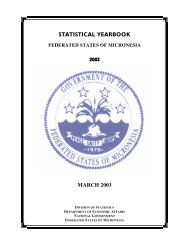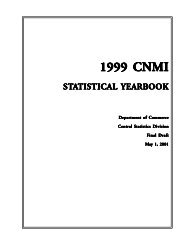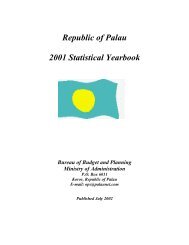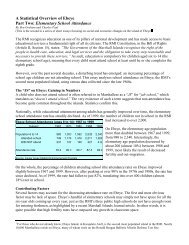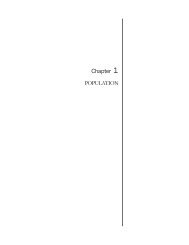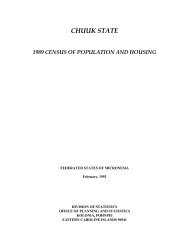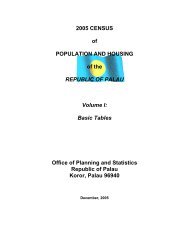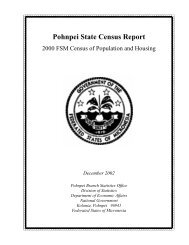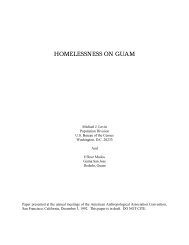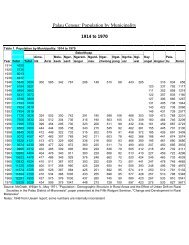Chapter 6. Migration2000 FSM <strong>Census</strong> of <strong>Chuuk</strong> <strong>State</strong>are losing people. The negative net migration rate in the Outer Islands was largely due to people moving to the Lagoonfor easier accessibility to the higher level of education, school facilities, and job market.Lifetime internal migration differed by sex. As shown in Table 6.4, census year 2000 data showed a change inlifetime internal migration such that female movers outnumbered their male counterparts, whereas in 1994 malemovers outnumbered the female movers. The female internal migrants in census year 2000 outnumbered their malecounterparts, with 932 compared to 773 males. The Outer Islands lost both males and females as a result of internallifetime migration. However, these people are recouped in the Lagoon.Table 6.4. Internal Lifetime Migration, <strong>Chuuk</strong> <strong>State</strong>: 1994 and 20001994 2000LifetimeLifetimeNon- In- Out- Net- Migration Non- In- Out- Net- MigrationRegion movers migrants migrants migrants Rate (%) movers migrants migrants migrants Rate (%)TotalLagoon 39,005 1,751 350 1,401 3.5 37,936 2,050 345 1,705 4.4Outer Islands 11,241 350 1,751 (1,401) (11.4) 12,778 345 2,050 (1,705) (12.3)MalesLagoon 19,832 875 204 671 3.3 19,304 960 187 773 4.0Outer Islands 5,651 204 875 (671) (10.8) 6,411 187 960 (773) (11.3)FemalesLagoon 19,173 876 146 730 3.7 18,632 1,090 158 932 4.8Outer Islands 5,590 146 876 (730) (12.0) 6,367 158 1,090 (932) (13.4)Source: 1994 FSM <strong>Census</strong>es, Table P17 & unpublished data; 2000 FSM <strong>Census</strong>, Table P2-5 & unpublished data.Citizenship and Legal ResidenceA similar migration pattern was found when place of birth was used to estimate migration flow and that is citizenship.Most residents in <strong>Chuuk</strong> were legal residents of <strong>Chuuk</strong> as shown in Table 6.5. The majority of the non-<strong>Chuuk</strong>ese werecitizens of other FSM states, accounting for about 41 percent, while U.S and Asian citizens accounted for about 25 and17 percents respectively. The majority of these non-<strong>Chuuk</strong>ese citizens resided in the Lagoon, accounting for less than1 percent of the total <strong>Chuuk</strong>ese population (more than 1 percent drop from 1994).Table 6.5: Usual Residence by Citizenship, <strong>Chuuk</strong> <strong>State</strong>: 1994 and 2000Country of citizenship1994 2000Other FSM Else- Other FSM Else-Usual residence Total Percent <strong>Chuuk</strong> states USA Asia where Total Percent <strong>Chuuk</strong> <strong>State</strong>s USA Asia whereTotal 53,319 100.0 98.2 0.4 0.4 0.9 0.1 53,595 100.0 99.5 0.2 0.1 0.1 0.1Lagoon 41,662 100.0 97.8 0.4 0.5 1.2 0.1 38,005 100.0 99.3 0.3 0.2 0.1 0.1N. Namoneas 17,093 100.0 95.1 1.0 0.9 2.8 0.2 10,360 100.0 97.8 1.0 0.5 0.4 0.4S. Namoneas 11,898 100.0 99.7 0.1 0.2 - - 12,373 100.0 99.8 0.1 0.1 … …Faichuk 12,671 100.0 99.7 - 0.1 0.1 - 15,272 100.0 99.9 … 0.1 - …Outer Islands 11,657 100.0 99.4 0.3 0.2 - - 15,590 100.0 100.0 … … - -Mortlocks 6,471 100.0 99.4 0.4 0.1 - - 8,848 100.0 100.0 … - - -Pattiw 2,171 100.0 99.3 0.2 0.5 - - 2,968 100.0 100.0 - - - -Namonwito 1,001 100.0 98.9 0.5 0.6 - - 1,433 100.0 99.9 - 0.1 - -Halls 2,014 100.0 100.0 - - - - 2,341 100.0 99.9 0.1 - - -Source: 1994 FSM <strong>Census</strong>es, Table P18; 2000 FSM <strong>Census</strong>, Table P2-6.In Table 6.6, the data show <strong>Chuuk</strong> legal residents in the FSM, presenting their place of usual residence. Legalresidence is defined as the place where a person is a registered voter during the election preceding the census. Suchinformation is especially useful in the decision-making process of appropriating government funds. The data show thatin both census years a vast majority of the population lived in their place of legal residence. For example, in the 2000<strong>Census</strong>, 97 percent of the Northern Namoneas legal residents were residing in Northern Namoneas at the time of thecensus. This also holds true for the Outer Islands, except for the Mortlocks of which about 76 percent lived in theirplace of legal residence.52 <strong>Chuuk</strong> Branch Statistics Office, Division of Statistics, FSM Department of Economic Affairs
2000 FSM <strong>Census</strong> of <strong>Chuuk</strong> <strong>State</strong>Chapter 6. MigrationTable 6.6: Municipality and <strong>State</strong> of Legal Residence by Municipality of Usual Residence, <strong>Chuuk</strong> <strong>State</strong>: 1994 and 2000Usual residenceLagoonOuter IslandsLegal residence Total Total N. Namoneas S. Namoneas Faichuk Total Mortlocks Oksoritod Other FSM1994Total 53,037 40,920 16,416 11,876 12,628 11,637 6,466 5,171 480Lagoon 37,503 37,178 12,747 11,844 12,587 25 15 10 300N. Namoneas 10,916 10,731 10,657 47 27 19 12 7 166S. Namoneas 12,677 12,593 874 11,695 24 3 2 1 81Faichuk 13,910 13,854 1,216 102 12,536 3 1 2 53Outer Islands 15,534 3,742 3,669 32 41 11,612 6,451 5,161 180Mortlocks 9,697 3,110 3,063 29 18 6,459 6,450 9 128Oksoritod 5,837 632 606 3 23 5,153 1 5,152 522000Total 53,909 40,184 14,492 11,664 14,028 13,124 6,908 6,216 601Lagoon 38,063 37,709 12,081 11,631 13,997 15 6 9 339N. Namoneas 10,337 10,121 10,031 77 13 9 3 6 207S. Namoneas 12,434 12,338 833 11,477 28 5 3 2 91Faichuk 15,292 15,250 1,217 77 13,956 1 - 1 41Outer Islands 15,846 2,475 2,411 33 31 13,109 6,902 6,207 262Mortlocks 9,054 1,940 1,885 30 25 6,905 6,901 4 209Oksoritod 6,792 535 526 3 6 6,204 1 6,203 53Source: 1994 FSM <strong>Census</strong>es, Table P18; 2000 FSM <strong>Census</strong>, Table P2-6.Continuous ResidenceData on continuous residence is used to determine migration levels and patterns. Table 6.7 gives the percentdistribution of the non-migrant population. In both census years, around 89 percent of the <strong>Chuuk</strong> population respondedthat they had been living in his or her present municipality of residence their entire life, or were non-movers. On theother hand, about 10 percent responded that they had changed place of residence, or were movers.The table also shows different migration levels and patterns between the regions. Persons in the Outer Islands weremore likely to be non-movers compared to the Lagoon. For instance, in 2000, over 95 percent of the Outer Islandresidents were non-movers compared to 88 percent in the Lagoon. These differences were partly due to the differentimmigration and in-migration levels experienced in the two areas.Table 6.7: Distribution of Non-movers and Previous Residence, <strong>Chuuk</strong> <strong>State</strong>: 1994 and 2000Place of ResidenceResidence since birth 1994 2000and previous place of residence Total Lagoon Outer Islands Total Lagoon Outer IslandsTotal 53,319 41,662 11,657 53,595 40,465 13,130Percent 100.0 100.0 100.0 100.0 100.0 100.0Lived in municipality since birth 88.8 87.5 93.5 90.1 88.3 95.4Previous residence elsewhere 11.2 12.5 6.5 9.9 11.7 4.6Source: 1994 FSM <strong>Census</strong>es, Table P18; 2000 FSM <strong>Census</strong>, Table P2-7..In Table 6.8 we take the movers (about 11 percent and 10 percent for 1994 and 2000, respectively) defined in Table 6.7as “previous residence elsewhere” and look at the duration of their residence and their previous place of residence.Between 1994 and 2000, the percentage of residents who had continuously resided in their municipality of residenceless than 6 months declined while the percentage continually resided in their municipality of residence for 2 to 5 yearsincreased. The proportion of persons who had continuously resided in their municipality of residence for 5 years ormore was over 60 percent. This pattern suggested that presently, people are more likely to move than before.In 2000, less than 10 percent of the movers previously resided outside <strong>Chuuk</strong>. Additionally, less than 1 percent of themovers previously resided in Asia, compared to 8 percent in 1994. This is due in part to the suspension of the TingHong fishing ventures in the interim.<strong>Chuuk</strong> Branch Statistics Office, Division of Statistics, FSM Department of Economic Affairs 53
- Page 5:
iii
- Page 12 and 13:
Preface2000 FSM Census of Chuukx
- Page 14 and 15:
Table of contents2000 FSM Census of
- Page 16 and 17:
LIST OF TEXT TABLESTABLEPageChapter
- Page 18 and 19:
List of Text Table2000 FSM Census o
- Page 20 and 21:
LIST OF FIGURESFIGUREPageFigure 1.1
- Page 22 and 23:
List of Basic-Tables2000 FSM Census
- Page 24 and 25:
MAP OF FSMxxiiChuuk Branch Statisti
- Page 27 and 28:
2000 FSM Census of Chuuk StateExecu
- Page 29 and 30: CHAPTER 1INTRODUCTIONThe creation o
- Page 31 and 32: 2000 FSM Census of Chuuk StateChapt
- Page 33 and 34: 2000 FSM Census of Chuuk StateChapt
- Page 35 and 36: 2000 FSM Census of Chuuk StateChapt
- Page 37 and 38: 2000 FSM Census of Chuuk StateChapt
- Page 39 and 40: 2000 FSM Census of Chuuk StateChapt
- Page 41 and 42: 2000 FSM Census of Chuuk StateChapt
- Page 43 and 44: 2000 FSM Census of Chuuk State Chap
- Page 45: 2000 FSM Census of Chuuk StateChapt
- Page 48 and 49: Chapter 2. Age and Sex Structure200
- Page 50 and 51: Chapter 2. Age and Sex Structure200
- Page 52 and 53: Chapter 2. Age and Sex Structure200
- Page 55 and 56: CHAPTER 3HOUSEHOLDS, FAMILIES, AND
- Page 57 and 58: 2000 FSM Census of Chuuk StateChapt
- Page 59 and 60: 2000 FSM Census of Chuuk StateChapt
- Page 61: 2000 FSM Census of Chuuk StateChapt
- Page 64 and 65: Chapter 4. Fertility2000 FSM Census
- Page 66 and 67: Chapter 4. Fertility2000 FSM Census
- Page 68 and 69: Chapter 4. Fertility2000 FSM Census
- Page 71 and 72: CHAPTER 5MORTALITYIntroductionAs re
- Page 73 and 74: 2000 FSM Census of Chuuk StateChapt
- Page 75: 2000 FSM Census of Chuuk StateChapt
- Page 78 and 79: Chapter 6. Migration2000 FSM Census
- Page 82 and 83: Chapter 6. Migration2000 FSM Census
- Page 84 and 85: Chapter 6. Migration2000 FSM Census
- Page 86 and 87: Chapter 7. Religion, Ethnicity, and
- Page 88 and 89: Chapter 7. Religion, Ethnicity, and
- Page 90 and 91: Chapter 7. Religion, Ethnicity, and
- Page 92 and 93: Chapter 8. Education2000 FSM Census
- Page 94 and 95: Chapter 8. Education2000 FSM Census
- Page 96 and 97: Chapter 8. Education2000 FSM Census
- Page 98 and 99: Chapter 8. Education2000 FSM Census
- Page 100 and 101: Chapter 8. Education2000 FSM Census
- Page 103 and 104: CHAPTER 9ECONOMIC ACTIVITYIntroduct
- Page 105 and 106: 2000 FSM Census of Chuuk StateChapt
- Page 107 and 108: 2000 FSM Census of Chuuk StateChapt
- Page 109 and 110: 2000 FSM Census of Chuuk StateChapt
- Page 111 and 112: 2000 FSM Census of Chuuk StateChapt
- Page 113 and 114: 2000 FSM Census of Chuuk StateChapt
- Page 115 and 116: 2000 FSM Census of Chuuk StateChapt
- Page 117 and 118: CHAPTER 10INDUSTRY AND OCCUPATIONIn
- Page 119 and 120: 2000 FSM Census of Chuuk StateChapt
- Page 121 and 122: 2000 FSM Census of Chuuk StateChapt
- Page 123 and 124: 2000 FSM Census of Chuuk StateChapt
- Page 125 and 126: 2000 FSM Census of Chuuk StateChapt
- Page 127 and 128: 2000 FSM Census of Chuuk StateChapt
- Page 129 and 130: CHAPTER 11INCOMEIntroductionThe 200
- Page 131 and 132:
2000 FSM Census of Chuuk StateChapt
- Page 133 and 134:
2000 FSM Census of Chuuk StateChapt
- Page 135 and 136:
2000 FSM Census of Chuuk StateChapt
- Page 137:
2000 FSM Census of Chuuk StateChapt
- Page 140 and 141:
Chapter 12. Housing2000 FSM Census
- Page 142 and 143:
Chapter 12. Housing2000 FSM Census
- Page 144 and 145:
Chapter 12. Housing2000 FSM Census
- Page 146 and 147:
Chapter 12. Housing2000 FSM Census
- Page 148 and 149:
Chapter 12. Housing2000 FSM Census
- Page 150 and 151:
Chapter 12. Housing2000 FSM Census
- Page 152 and 153:
Chapter 12. Housing2000 FSM Census
- Page 154:
Chapter 12. Housing2000 FSM Census
- Page 157 and 158:
BIBLIOGRAPHYArriaga, E.E., (1983).
- Page 159:
2000 FSM Census of Chuuk StateBibli
- Page 162 and 163:
Basic Tables2000 FSM Census of Chuu
- Page 164 and 165:
Basic Tables2000 FSM Census of Chuu
- Page 166 and 167:
Basic Tables2000 FSM Census of Chuu
- Page 168 and 169:
Basic Tables2000 FSM Census of Chuu
- Page 170 and 171:
Basic Tables2000 FSM Census of Chuu
- Page 172 and 173:
Basic Tables2000 FSM Census of Chuu
- Page 174 and 175:
Basic Tables2000 FSM Census of Chuu
- Page 176 and 177:
Basic Tables2000 FSM Census of Chuu
- Page 178 and 179:
Basic Tables2000 FSM Census of Chuu
- Page 180 and 181:
Basic Tables2000 FSM Census of Chuu
- Page 182 and 183:
Basic Tables2000 FSM Census of Chuu
- Page 184 and 185:
Basic Tables2000 FSM Census of Chuu
- Page 186 and 187:
Basic Tables2000 FSM Census of Chuu
- Page 188 and 189:
Basic Tables2000 FSM Census of Chuu
- Page 190 and 191:
Basic Tables2000 FSM Census of Chuu
- Page 192 and 193:
Basic Tables2000 FSM Census of Chuu
- Page 194 and 195:
Basic Tables2000 FSM Census of Chuu
- Page 196 and 197:
Basic Tables2000 FSM Census of Chuu
- Page 198 and 199:
Basic Tables2000 FSM Census of Chuu
- Page 200 and 201:
Basic Tables2000 FSM Census of Chuu
- Page 202 and 203:
Basic Tables2000 FSM Census of Chuu
- Page 204 and 205:
Basic Tables2000 FSM Census of Chuu
- Page 206 and 207:
Basic Tables2000 FSM Census of Chuu
- Page 208 and 209:
Basic Tables2000 FSM Census of Chuu
- Page 210 and 211:
Basic Tables2000 FSM Census of Chuu
- Page 212 and 213:
Basic Tables2000 FSM Census of Chuu
- Page 214 and 215:
Basic Tables2000 FSM Census of Chuu
- Page 216 and 217:
Basic Tables2000 FSM Census of Chuu
- Page 218 and 219:
Basic Tables2000 FSM Census of Chuu
- Page 220 and 221:
Basic Tables2000 FSM Census of Chuu
- Page 222 and 223:
Basic Tables2000 FSM Census of Chuu
- Page 224 and 225:
Basic Tables2000 FSM Census of Chuu
- Page 226 and 227:
Basic Tables2000 FSM Census of Chuu
- Page 228 and 229:
Basic Tables2000 FSM Census of Chuu
- Page 230 and 231:
Basic Tables2000 FSM Census of Chuu
- Page 232 and 233:
Basic Tables2000 FSM Census of Chuu
- Page 234 and 235:
Basic Tables2000 FSM Census of Chuu
- Page 236 and 237:
Basic Tables2000 FSM Census of Chuu
- Page 238 and 239:
Basic Tables2000 FSM Census of Chuu
- Page 240 and 241:
Basic Tables2000 FSM Census of Chuu
- Page 242 and 243:
Basic Tables2000 FSM Census of Chuu
- Page 244 and 245:
Basic Tables2000 FSM Census of Chuu
- Page 246 and 247:
Basic Tables2000 FSM Census of Chuu
- Page 248 and 249:
Basic Tables2000 FSM Census of Chuu
- Page 250 and 251:
Basic Tables2000 FSM Census of Chuu
- Page 252 and 253:
Basic Tables2000 FSM Census of Chuu
- Page 254 and 255:
Basic Tables2000 FSM Census of Chuu
- Page 256 and 257:
Basic Tables2000 FSM Census of Chuu
- Page 258 and 259:
Basic Tables2000 FSM Census of Chuu
- Page 260 and 261:
Basic Tables2000 FSM Census of Chuu
- Page 262 and 263:
Basic Tables2000 FSM Census of Chuu
- Page 264 and 265:
Basic Tables2000 FSM Census of Chuu
- Page 266 and 267:
Basic Tables2000 FSM Census of Chuu
- Page 268 and 269:
Basic Tables2000 FSM Census of Chuu
- Page 270 and 271:
Basic Tables2000 FSM Census of Chuu
- Page 272 and 273:
Basic Tables2000 FSM Census of Chuu
- Page 274 and 275:
Basic Tables2000 FSM Census of Chuu
- Page 276 and 277:
Basic Tables2000 FSM Census of Chuu
- Page 278 and 279:
Basic Tables2000 FSM Census of Chuu
- Page 280 and 281:
Basic Tables2000 FSM Census of Chuu
- Page 282 and 283:
Basic Tables2000 FSM Census of Chuu
- Page 284 and 285:
Basic Tables2000 FSM Census of Chuu
- Page 286 and 287:
Basic Tables2000 FSM Census of Chuu
- Page 288 and 289:
Basic Tables2000 FSM Census of Chuu
- Page 290 and 291:
Basic Tables2000 FSM Census of Chuu
- Page 292 and 293:
Questionnaire2000 FSM Census of Chu
- Page 294 and 295:
Questionnaire2000 FSM Census of Chu
- Page 296 and 297:
Questionnaire2000 FSM Census of Chu



